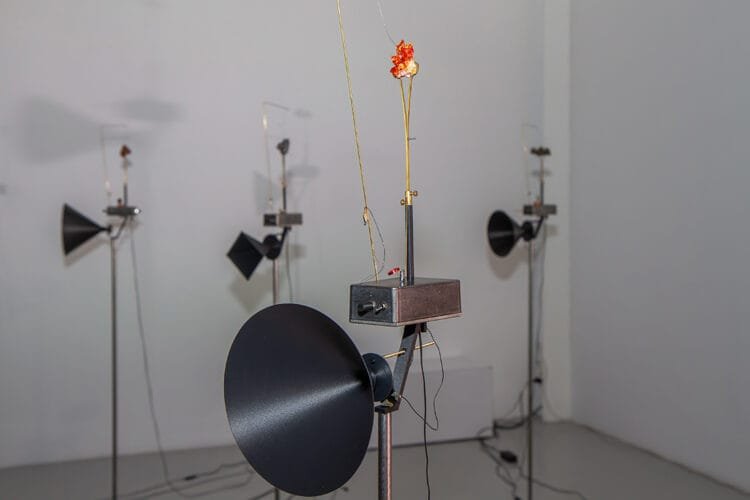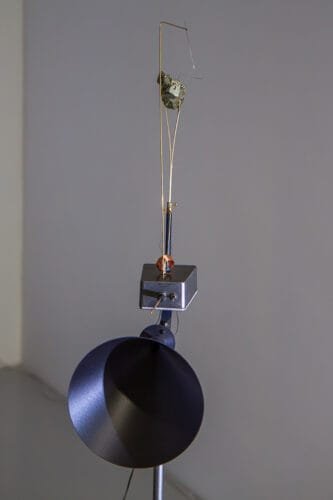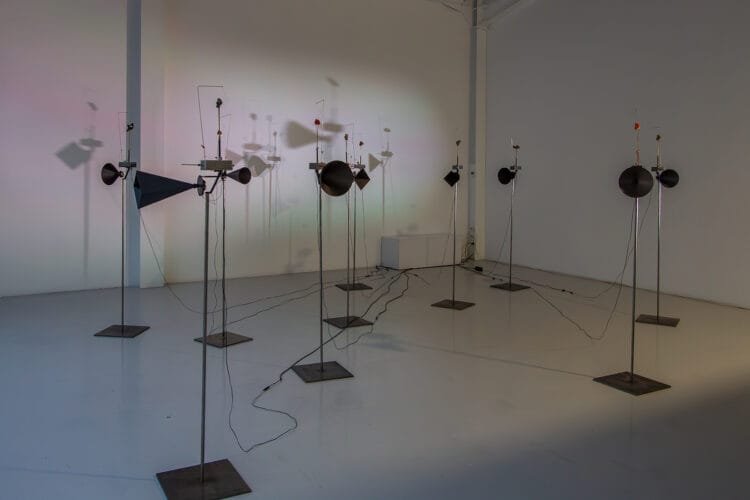A full, abrasive, continuous sound that disrupts both background noise and attention, but which allows the coexistence of sound flows from different origins, cracks a white space separated from the apparent outside world by a transparent soundproofing – a glass wall that lets you look out, but not hear what might interfere from beyond this boundary. An auditory installation dominates the experiential space in a potential sound hierarchy. Dispersed structures, composed of coils and capacitors, produce fluctuating sounds when touched, changing the sound nuances as the needle moves over the mineral pieces that “scream,” as the perceptive process is described by Ioana Vreme Moser, the artist who gradually tests a possible relationship with the underlying aesthetic intimacy, rather silent, on a symbolic background. Silent not to the extent of an absence, but to the point of such a natural and almost unifying doubling of the visual environment through the activation of soundscapes. This undifferentiated merging of media occurs as in the case of surfaces, which, through overlapping, although they lose their ability to arrange all their layers, form a new object, coherent through symbiosis.
The emergence of sound art in the visual arts space, beyond a presumed separation, reminds us that experience can be dictated by two perspectives that can function alternately, not just simultaneously. What Ioana Vreme Moser achieves in the context of the exhibition curated by Horațiu Lipot, “ELECTRIC PERIPHERIES → PERIKON”, is to complete the auditory experience through a metonymic exercise: the technological objects, silent as they are, are associated with noise, a scream that they produce, so that, once reintegrated into the everyday sound space, the gadgets receive an autonomous auditory identity, therefore independent of the usual sonic economy. Rewriting the interaction with them is thus translated through this alternation: crossing the border of the exhibition space frees sound art from its own acoustic reverberations, for it is only when it continues in the imagined visual space, and thus silent, that noise becomes experimental music and, implicitly, soundscape. Sound art achieves its goal not through its own musicality, which is more akin to classical compositions, but through the noise produced within the context of invisible auditory segregation. It can thus be said that sound art gives voice to the dimension that cannot exercise its right to noise, regardless of the forms or intentions that generate it, whether objects or people. By referencing philosophy and technological production, Ioana Vreme Moser creates a soundscape that does not stand out as self-contained, through which the “viewer as listener” can undergo a journey that continuously shapes their subjectivity, as would usually be the case when experiencing such an architectural acoustic structure. She manages to deeply individualize it, offering the participant a variety of scenarios that would imaginatively generate their own soundscape, detached from and, at the same time, within the ambient noise of the city as they physically move through a dualistic perceptual space.
Ioana Vreme Moser’s artistic research proposes understanding the accident from two perspectives. On the one hand, tracing the history of zincite, a mineral resulting from mining accidents, she displays its material changes in successively altered mineral forms. On the other hand, or perhaps complementarily, the dissemination of distinct sounds, differentiated by human intervention, also appears accidental, given the mechanism of production—more precisely, one that is artificially composed, through the augmentation of natural matter with electrical structures, but which does not generate fixed sounds that can be manipulated like musical notes. What Ioana Vreme Moser achieves through her dual approach to accident in relation to sound is to highlight the spontaneity of the auditory dimension or, more specifically, the way in which the soundscape is continuously reconfigured in the source-receiver dyad.
Why does sound art have the potential to be legitimately separated from its visual context? Because sound is not just an acoustic phenomenon, but a dimension that connects the body to space, time, and memory. Listening is a fluid practice, a gesture of questioning the place and those who inhabit it. Unlike sight, which cuts out and divides, hearing expands, penetrates, and becomes complicit with the invisible. Through sound, space is no longer a fixed configuration, but an unfolding path, a rhythm that carries us forward without asking where it begins or ends.
In the tradition of French cultural theory, Michel de Certeau proposed the idea that space is shaped by everyday practices, and listening can be seen as such a practice – a way of inhabiting the world other than through sight. If sight renders space into an object of knowledge, sound renders it into an affective and relational process. Gaston Bachelard, in turn, in The Poetics of Space, also suggested that auditory perception is an anchor of intimacy, a way of creating inner shelters in a fluctuating external environment.
When walking, the ear becomes an organ of orientation. Echoes, tones, and sound distances create a sensitive map, a network of fluid landmarks that allow movement without the need for a visual vanishing point. For the nomad, the soundscape is a code to be deciphered, an ephemeral alphabet of presence. For the exiled, it is a thin thread of continuity, a sign that space can be found even when the ground has been lost. Marc Augé, in Non-Lieux, describes contemporary transitional spaces (airports, train stations, highways) as places that drain experience of meaning, but sound can fill this void, becoming a way to revive the place with presence and memory.
Moreover, this suspended meaning in the non-places described by Augé correlates with Mark Fisher’s analysis of capitalist realism and temporal imprisonment. Fisher describes a world in which the past and future seem to have been swallowed up by a perpetual present, a present that no longer allows for innovation or return. Non-places thus become not only transitory spaces, but also spaces of temporal blockage, where the individual is caught in a continuous replay of experience, unable to imagine anything else. Yet the soundscape can break this stasis. Unlike fixed architectural structures, sound has the ability to generate new temporal dimensions. A familiar sound can evoke the past and reactivate memory, while an unfamiliar soundscape can open up future possibilities. Thus, listening becomes a strategy for diverting the everlasting present, a way of reintroducing temporal flow into a space that would otherwise be condemned to stagnation.
But listening is not only a tool for orientation, but also a form of belonging. The sounds we carry with us define our presence, connect us to others, and anchor us in an invisible emotional network. Sound traces an inner space that survives uprooting. Roland Barthes, in Fragments d’un discours amoureux, observes that sound (especially the voice) is a sign of presence even in absence, a substitute for corporeality that intensifies sensitive connections precisely through these conditions. Thus, listening not only guides us but also anchors us emotionally in the spaces we pass through.
In such an auditory ecology, listening becomes a technique for survival in a territory that refuses stability. The soundscape not only guides us, but also transforms us, making us part of a continuous flow of appearances and absences, voices and echoes. In a world dominated by images, where visibility is synonymous with existence, sound reintroduces the hidden dimension of reality, the one that requires us to listen, to be touched by the veiled presence of the other, and to enter into the relational space by generating an ever-changing affective cartography. Ioana Vreme Moser uses these tools and, in a limited format, almost miniaturized in comparison to the real scale of the world, opens the viewer’s eyes to the sound that surrounds them.
Ioana Vreme Moser’s solo show, “ELECTRIC PERIPHERIES → PERIKON”, curated by Horațiu Lipot took plac at Borderline Art Space, Iași during March 6 – April 4, 2025.
Translated by Camelia Diaconu
POSTED BY
Lorena Marciuc
Lorena Marciuc is currently pursuing her PhD at the George Enescu National University of Arts in Iași, Romania, where she is researching the relationship between curatorial and auditory practices....







Comments are closed here.